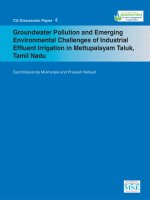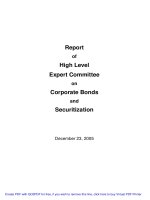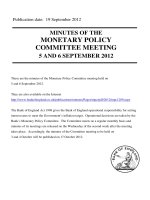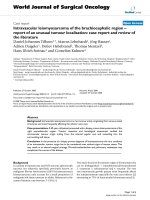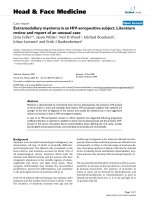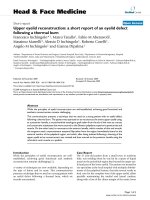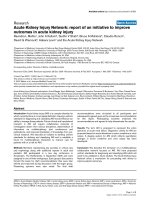Report of an Intercountry Expert Committee Meeting, Madurai, Tamil Nadu, India, 25-28 September 2001 doc
Bạn đang xem bản rút gọn của tài liệu. Xem và tải ngay bản đầy đủ của tài liệu tại đây (99.4 KB, 32 trang )
SEA-HE-184
Distribution: Limited
Education for
Health Promotion
Report of an Intercountry Expert Committee Meeting,
Madurai, Tamil Nadu, India, 25-28 September 2001
WHO Project: ICP HPR 001
World Health Organization
Regional Office for South-East Asia
New Delhi
April 2002
(C) World Health Organization (2002)
This document is not issued to the general public, and all rights are reserved by the World Health
Organization (WHO). The document may not be reviewed, abstracted, quoted, reproduced or
translated, in part or in whole, without the prior written permission of WHO. No part of this
document may be stored in a retrieval system or transmitted in any form or by any means electronic, mechanical or other – without the prior written permission of WHO.
The views expressed in documents by named authors are solely the responsibility of those
authors.
CONTENTS
Page
1. INTRODUCTION/BACKGROUND ..............................................................................................1
2. OBJECTIVES ............................................................................................................................................2
3. PARTICIPANTS AND PROGRAMME...........................................................................................2
4. INAUGURAL SESSION ......................................................................................................................3
5. OVERVIEW OF GLOBAL EDUCATION FOR HEALTH PROMOTION.......................5
6. OVERVIEW OF REGIONAL EDUCATION FOR HEALTH PROMOTION..................5
7. COUNTRY PRESENTATIONS.........................................................................................................6
7.1
7.2
7.3
7.4
7.5
7.6
7.7
7.8
7.9
Bangladesh .................................................................................................6
Bhutan........................................................................................................6
India...........................................................................................................6
Indonesia ....................................................................................................7
Maldives .....................................................................................................8
Myanmar....................................................................................................8
Nepal .........................................................................................................8
Sri Lanka.....................................................................................................8
Thailand .....................................................................................................8
8. ANALYTICAL REVIEW OF EDUCATION PROGRAMMES FOR
HEALTH PROMOTION IN MEMBER COUNTRIES..............................................................9
8.1 Group Work............................................................................................ 10
8.2 Presentation of Core Units, Elements, Knowledge and
Competencies in Health Promotion ......................................................... 10
8.3 Effective Teaching for Health Promotion .................................................. 16
9. EFFECTIVE TEACHING ................................................................................................................... 17
9.1 Country Presentations.............................................................................. 17
9.2 Group Presentations................................................................................ 18
9.3 Institutional Capacity on Bu ilding of Strategies ......................................... 19
Page iii
10. BENCHMARK INDICATORS............................................................................. 19
11. NETWORKING................................................................................................. 21
12. RECOMMENDATIONS..................................................................................... 22
12.1 Countries ...................................................................................................................................23
12.2 WHO ..........................................................................................................................................23
13. CONCLUSION ............................................................................................... 24
Annexes
1. List of Participants............................................................................................. 25
2. Programme....................................................................................................... 27
Page iv
1.
INTRODUCTION/BACKGROUND
Health promotion has emerged as a cornerstone of contemporary public
health that aims to advance the physical, social, and mental health of the
wider community. The antecedents of health promotion can be traced to the
need to control noncommunicable diseases. Health education is an integral
component of health promotion. In contrast to the narrow focus of health
education, health promotion addresses the broader environmental and
lifestyle determinants that impact on health. In doing so, it seeks to maintain a
balance between individual responsibilities and broader societal
responsibilities in the area of health development.
Some of the new health challenges and problems in the health scenario
include changing demographic trends, increased urbanization, increase in the
geriatric population, rising prevalence of chronic diseases, new and emerging
infectious diseases, behavioural and lifestyle related problems, and greater
prevalence of mental health problems. The situation is further compounded
by the influence of transnational factors, the global economy, financial market
and trade, access to media and communication technology and
environmental degradation. Thus health education and health promotion
must emphasize responses to health determinants and positive lifestyles
besides building a supportive environment for prevention of disease,
promotion, and protection of health.
In response to various WHO global resolutions on health education and
health promotion, several Member Countries, through WHO support, have
initiated training for health educators. However, most of these programmes in
health education focus on disease prevention rather than on health promotion
and health protection.
Existing programmes impart skills and knowledge pertaining to health
education rather than an all inclusive health promotion course. Strengthening
human resource development is one of the forms of strategic support to
strengthen national capacity for effective health promotion.
Page 1
Report of an Intercountry Expert Committee Meeting
The four-day intercountry expert meeting conducted from 25 to28
September 2001, was the outcome of a perceived need to restructure the
existing curricula in health education to enable trainees acquire knowledge
and skills to effectively respond to the new demands of health promotion. The
need to incorporate subject areas such as changing epidemiological a
nd
demographic trends, information technology, health determinants and lifestyle
factors, and health promotion tools such as advocacy in addition to IEC and
behavioural change cannot be overemphasized.
2.
OBJECTIVES
Following are the objectives of the expert meeting:
(1) To review the framework of the core curriculum for education of health
promotion in the Region;
(2) To propose a mechanism for regional networking on health promotion
and education, and
(3) To propose recommendations for further strengthening of education for
health promotion in the Region.
3.
PARTICIPANTS AND PROGRAMME
Twenty-six experts from Bangladesh, Bhutan, India, Indonesia, Maldives,
Myanmar, Nepal, Sri Lanka, and Thailand attended the meeting. They
represented the health and education ministries of the governments
concerned as well as the training institutions where certificate/diploma/
degree courses in health promotion are conducted. The facilitators included
Dr Desmond O’Byrne, Coordinator, LEC/HPS, WHO/Geneva, Switzerland;
Dr K C Tang, WHO-Consultant, Sydney, Australia; Ms Martha R. Osei,
Regional Adviser, Health Promotion and Education Unit, WHO/SEARO, New
Delhi; and Dr N Kumara Rai, Acting Director, Health Services and
Community Health, WHO/SEARO, New Delhi.
The programme of the expert meeting, structured to fulfil its objectives,
took into consideration the need for strengthening the capacity of Member
Countries in responding effectively health promotion demands; strengthening
Page 2
Education for Health Promotion
health promotion educational and training curricula in the Member Countries
by building on existing health educational training curricula and a regional
network training institute that could adopt and promote the core training
curricular content for health promotion.
This was achieved through 14 strategized plenary sessions, five group
discussions/sessions and presentations, as well as on the core curricular
content for the various levels of training and distribution of relevant
documents. To facilitate effective conduct of the sessions, the following
participants were nominated as chairperson, vice - chairperson, and
rapporteur:
(1)
(2)
Dr P C Das: Vice-Chairperson
(3)
4.
Mr Mohammed Shah Bhuiyan: Chairperson
Mr Dorji Wangchuk: Rapporteur
INAUGURAL SESSION
In her welcome address, Dr (Ms) Vijaya Srinivasan said that there was an
imminent need to provide direction to the WHO Member Countries to
standardize health promotion education.
Dr Desmond O’Byrne, Coordinator, LEC/Health Promotion Services,
WHO Headquarters, Geneva; and Dr Ananda Kannan, Vice-Chancellor, Dr
MGR Medical University, Chennai and Dr Kumara Rai, Acting Director,
Community Health Services, WHO/SEARO inaugurated the meeting by
lighting the ceremonial lamp. Representatives of the Member Countries also
lit the lamp to symbolize a collective global approach on health promotion
practices.
In his opening remarks, Dr Desmond O’Byrne mentioned that although it
had been in existence since ancient times, health promotion, as we know it
now, acquired a special focus since the Ottawa Conference in 1986. Living as
we do in times of global influences on health, he said, “it is perhaps the best
of times and the worst of times” for there are operative forces that promote
and hinder health. Health promotion implies promotion of peace for it
involves an extra challenge to show sensitivity and concern for all people
Page 3
Report of an Intercountry Expert Committee Meeting
regardless of colour, nationality or race. He, however, reiterated that while
health promotion is an important element in working towards the health and
well-being of people; it is not a panacea for health problems. Political
commitment and supportive environments are required in support of health
promotion if it is to be effective.
Dr Uton Muchtar Rafei, Regional Director, WHO, set the tone of the
meeting in his address read out in absentia by Dr Kumara Rai. He emphasized
the need for effective health promotion action in the Member Countries at
the national level, in view of the increased burden of diseases triggered by
epidemiological and demographic changes and lifestyle factors. He said that
healthy public policies which effectively respond to the health needs of
communities are the dire need of the day. He reiterated that community
empowerment and partnerships between various sectors, organizations, and
communities are critical to the success of health promotion and indicators of
effective health promotion.
Dr Ananda Kannan, Vice-Chancellor, Dr MGR Medical University, in his
key note address, highlighted the importance of the truism, ‘Health is wealth’
referring to public health indices such as increased life expectancy at the
beginning and end of the twentieth century. Health being an important social
indicator, it is imperative to evolve a strategy towards holistic improvement of
health. He said that health status depended on improved nutrition, better
living conditions, sanitation, g
ood drinking water, protected environment,
adequate road facilities, transportation, and primary education.
Dr Ananda Kannan remarked that some of the current challenges in
health promotion would include bringing down the fertility rate and infant
mortality rates; to implement universal primary immunization and primary
education; promote delayed marriage for girls; increase the female literacy
rate and reduce the incidence of school drop outs. Possible strategic options
to tackle these issues include maximi ing human resources; interfacing of
z
extension workers in health care with the people; developing a cohesive
health care team; increasing health awareness of people through media;
making health care affordable and accessible to all people; and making health
education and health promotion common across all systems of medicine.
Page 4
Education for Health Promotion
5.
OVERVIEW OF GLOBAL EDUCATION FOR
HEALTH PROMOTION
Dr Desmond O’Byrne in his presentation provided a brief overview of health
promotion history, and spelt out the five priorities for h ealth promotion in the
twenty-first century. He also emphasized the need for institutional capacity
building and training in health promotion. Reiterating that “we live in a global
village and cannot work in isolation”, Dr O’Byrne stressed the need for a
holistic, comprehensive, and interdependent approach to health promotion.
Such an approach would entail spelling out the entry points to mobilize an effective
health promotion strategy that would underscore the work of the health services
and reach out to and motivate other sectors of society for health action.
While much has been done in the field of health promotion, much more
needs to be done. Strategic directions need to be adopted to ‘create a cadre
of professional health promoters who act as yeast or catalysts” in spearheading
health promotion activities in society. These include strengthening the
curriculum for education and training for health promotion, and enlisting
greater community participation to reduce the burden of disease on the poor
and the marginalized.
6.
OVERVIEW OF REGIONAL EDUCATION FOR
HEALTH PROMOTION
“The South-East Asian Region is in transition. Political, social, economic,
environmental, technological, demographic, and epidemiological changes
now taking place are posing unprecedented health challenges,” said Mrs
Martha Osei while providing an overview of the regional education
programmes for health promotion. The role of health promotion training lies
in “strengthening national capabilities in all aspects of health promotion,
especially in the training of human resource”.
A three-fold strategy for health promotion in developing countries
involves advocacy, mediation of sectoral interest for health and social support
and community empowerment for health. Some of the challenges for health
promotion in the Region involve closing the gaps and inequities in health;
ensuring basic health services to all; and placing health at the centre of
development on national health promotion. There is a need for graduates
Page 5
Report of an Intercountry Expert Committee Meeting
from our training institutions to have the appropriate skills, knowledge and
hands on experience to meet these challenges.
7.
COUNTRY PRESENTATIONS
Representatives of the Member Countries made presentations on the various
health promotion training courses in their countries.
7.1
Bangladesh
Bangladesh conducts a Master’s Programme in Health Promotion and
Education (MPH). The course equips candidates to plan, initiate, conduct,
and evaluate the educational aspects of health programmes at various
organizational levels so that the trainers’ could assume faculty positions in
medical and health institutions. The course covers major areas of health
promotion/health education, including the history of health promotion, and
evaluation and research. The teaching strategy consists of lectures, seminars,
field practice, and Concurrent Field Training (CFT).
7.2
Bhutan
The Royal Institute of Health Sciences offers diploma course for general nurse
midwife; certificate courses for health assistants, auxiliary nurse midwives,
basic health workers, assistant nurses and technicians. The Institute also
conducts upgradation courses for health assistants and basic health workers.
The courses deal with the following aspects of health education: community
diagnosis, educational diagnosis, process of planning for health education,
communication skills, interpersonal communication, counselling and teaching
methodologies. The courses provide students adequate exposure to both
clinical medicine and community health. The teaching methodology is
participatory and student-centred and based on modern technologies.
7.3
India
Diploma in Health Education training is conducted by two institutions namely
Central Health Education Bureau, New Delhi and the Gandhigram Institute of
Rural Health and Family Welfare Trust (GIRH & FWT), Tamil Nadu.
Page 6
Education for Health Promotion
The various training programmes/courses conducted by the Central
Health Education Bureau (CHEB) equip candidates with expertise to
function as health educators/health promoters at different levels in the
country. The institute currently offers the following courses:
Ø A two-year post graduate diploma in health education for doctors,
and paramedical professionals including nurses and postgraduates
in sociology, anthropology, and behavioural sciences.
Ø A key trainer’s course in health education for faculty of state
training centres,
organizations.
district
training
centres
and
voluntary
Ø Certificate course in health education for paramedical officials.
Gandhigram Institute of Rural Health and Family Welfare Trust
(GIRH & FWT)
The institute offers a postgraduate diploma in health promotion and
education awarded by Dr MGR Medical University, Chennai. The course
prepares candidates to become basic/professional health educators who
can plan, implement, and evaluate health education programmes in the
country at all levels. The core components of the course include theory,
practical, observation visits, Concurrent Field Training (CFT), and
Supervisory Field Training (SFT). The faculty includes health professionals
such as epidemiologists, public health experts, health administrators,
environmentalists, nutritionists, statisticians, demographers, health
educators, behavioural scientists, researchers, and communication experts.
7.4
Indonesia
Broadly speaking, the country’s education for health promotion
programme can be divided into two categories: special education for
health promotion and health promotion as a component of other
disciplines. The former consists of diploma, degree, and short courses in
health promotion. The latter consists of health promotion training as a
component of disciplines such as diploma programmes in nutrition and
nursing; and degree programmes and short courses in disciplines such as
medicine, dentistry, nursing, and pharmacology.
Page 7
Report of an Intercountry Expert Committee Meeting
7.5
Maldives
The country’s Faculty of Health Sciences (FHS) offers the following health
promotion courses: certificate and diploma in primary health care, and
certificate courses to train nurse aides and community level health workers. The
institute also conducts in-service training for health workers in health pro motion
concepts and training workshops in Information Education and communication
(IEC).
7.6
Myanmar
Myanmar’s Institute of Community Health (IOCH) equips candidates to
become Five Star Health Assistants (HA) capable of providing quality health
care to the community. On completing the course, candidates would have
acquired relevant knowledge, skills and attitude in community health, and also
be capable of applying it to implement and evaluate health programmes.
7.7
Nepal
Nepal periodically conducts health education courses to meet the requirements
of institutions. These courses are either general or programme specific. The
country conducts programme-specific health promotion course in the following
areas: family planning, adolescent health, safe motherhood, oral health, dental
health, lifestyle and nutrition.
7.8
Sri Lanka
The national universities, the Health Education Bureau, the National Institute of
Health Sciences, and provincial primary health care training centres provide
training for health promotion for different categories of health workers.
7.9
Thailand
Thailand offers the following programmes in public health and related health
sciences: a degree programme (B.Sc.) in public health, a master’s programme in
public health, and a doctoral programme. The programmes focus on an
integrated approach to health promotion, thereby preparing the students to
play leadership roles in the field of research and health education and
promotion at all levels.
Page 8
Education for Health Promotion
8.
ANALYTICAL REVIEW OF EDUCATION PROGRAMMES
FOR HEALTH PROMOTION IN MEMBER COUNTRIES
Dr K C Tang, Australian Centre for Health Promotion, University of Sydney
presented the findings of the analytical review of selected training
programmes in the Region. The teaching
-learning context in health promotion
needs to be looked at from the following perspectives:
Ø
An institution with capacity,
Ø
A quality curriculum,
Ø
A competent workforce, and
Ø
Population health – the raison d’être for any course in health
promotion.
A framework for curriculum development must incorporate the
following elements: core elements (what is taught or learnt), approaches and
methods (how it is taught or learnt), students, trainees (for whom or by
whom), and faculty members (by whom or who facilitate the learning). A
combination of competency-based an d problem-based approaches is
necessary to bring about a good fit between learning outcomes and job task
accomplishments.
Some of these assertions have been confirmed by the findings of the key
informant interviews undertaken in several Member Countries in the Region.
Typical comments include:
Ø “Classroom and reference materials are often lacking”
Ø “Access to the Internet by students is quite limited”
Ø
“(Students) like to be spoon fed, are passive (and) do not participate
well in discussion groups partly because of the paternalistic culture
which does not encourage students to express their own views”
Apart from factors relating to student issues and teaching resources,
inappropriate teaching styles and assessment formats were also found to be
barriers to effec tive teaching, as revealed by the findings of the key informant
interviews. It was found that the great majority of the teaching staff in the
Region was:
Page 9
Report of an Intercountry Expert Committee Meeting
Ø “Didactic (and) often too theoretical (and their teachings are) often
not relevant to real life situations or difficult to apply to real life
situations.”
Ø “Teachers (also) do not encourage students to participate or take an
active role in learning and there is often a “we and them” gap
between faculty members and students”.
To ensure that committed and suitably qualified students are recruited,
criteria for selection need to be developed and a structured process for
selection must also be developed and implemented. There has been concern
about the lack of a pool of quality trainers. It is not uncommon in many
institutes in the Region that, “there are not many teaching staff members who
possess a doctoral degree in health promotion or a related discipline (and)
many of them have rather limited working experience in health promotion.”
8.1
Group Work
Based on the guidelines for group work provided by Ms Osei and Dr Tang,
participants were divided into four groups. They worked out the core
elements of education for health promotion towards evolving a tailor-made
health promotion-training programme for the Region. The groups worked on
the following courses:
Group 1: Basic/Diploma training
Group 2: Bachelor’s Degree
Group 3: Postgraduate Diploma
Group 4: Master’s Degree
8.2
Presentation of Core Units, Elements, Knowledge and
Competencies in Health Promotion
What is taught and learnt
For effective health promotion and education, health promoters must possess
the requisite knowledge, skills and beliefs/values for undertaking their day-today activities in an outcome-focused, equity-driven, community-based and
cost-efficient manner.
Page 10
Education for Health Promotion
The experience in both developed and developing countries confirms
that education and training programmes sometimes fail to equip their
graduates with the requisite knowledge, skills and values to address real life
work problems or situations. There must be a good fit between the learning
outcomes of such education or training programmes and the job task
accomplishment in real life practice. Graduates of such programmes must also
be able to apply what they learn from the programmes to real life practice.
that:
Through the key informant interviews and agency visits, it was found
Ø The knowledge and skills required for job task accomplishment are
not covered or not covered adequately in the curriculum of the
existing education and training programmes
Ø Self development should continue to be a key emphasis of the
curriculum and there should also be a requirement for graduates to
identify and promote the values and beliefs that underpin health
promotion, and
Ø Skills development can further be strengthened as a key emphasis of
the curriculum.
For example, “health and development” can be a study unit in the
Region’s curriculum and its elements of competency may include: alleviating
poverty, facilitating easy access to health care, recognizing the effects of
urbanization on environmental health, understanding international
organizations at work and minimizing the negative health effects due to
economic globalization.
A key part of the existing programmes provided by education and training
institutes in the Region is social casework skills and it is important that this
training be retained. Practitioners in health promotion and education should
continue to be equipped with social casework skills including counselling skills
so as to enhance the life skills of their clients, particularly students. They must
also be given opportunities to enhance their cognitive ability such as the
development of their decision-making, problem-solving and critical thinking
abilities.
It is becoming increasingly common in the Region for health promotion
and education practitioners to come from not only the ranks of medical
doctors, nurses and other health -related professionals, but also graduates of
Page 11
Report of an Intercountry Expert Committee Meeting
other disciplines such as teachers, psychologists and social workers. It is
important for the latter group to be given knowledge of and skills in basic
medical and health sciences, for example, human biology, causes and history of
common diseases, hygiene and sanitation, medical and health related terms
and their explanations and epidemiology as well as behavioural research.
Practitioners in health promotion and education in the Region repeatedly
revealed that there is an urgent need for them to enhance their skills in a
number of areas, including skills in building partnership with all key
stakeholders, empowering community, advocating the paramount importance
of the contributions of health promotion and education, conducting research,
evaluating actions and disseminating results.
With reference to the widespread consultation with key stakeholders in the
six countries visited by the consultant and the literature review, nine units of
competency were proposed for inclusion in certified health promotion and
education programmes in the Region, together with input from the Regional
Office. Within each of these units of competency, a set of elements of
competency was also proposed.
It is important to note that these units and elements are developed based
on the experience in education and training as well as real life practice in both
Australia and countries in the Region. For information and reference purposes,
two sets of competency standards for health promotion in Australia 1 2 were also
extracted and attached to a background paper for the participants of the
Experts’ Meeting for perusal and reference.
The participants of the Experts’ Meeting recognized that those two sets of
standards were developed in Australia, respectively in the mid and late 1990s.
While the great majority of those standards are relevant to the HP practice in
the Member C
ountries of the Region, there are also other competencies
required for best practice in health promotion in developing countries that are
not covered by those standards. Given the different health issues
encountered, the different intervention methods used and the different
infrastructures between Australia and the Member Countries in the Region, in
addition to the different political, economic and social contexts, ten units of
NSW Department of Health (1994) Competency based standards for health promotion in NSW. NSW
Department of Health, Sydney.
2
Shilton, T., Howat, P., James, R. & Lower, T. (2001) Health Promotion Development and Health
Promotion Workforce Competency in Australia. Health Promotion Journal of Australia 12 (2), 117-123.
1
Page 12
Education for Health Promotion
competency were developed to be included in certified health promotion and
education programmes as specified in Table 1. The units and elements of
competency that should be included in four different degree programmes
(undergraduate diploma, bachelor, postgraduate diploma and master) were
also identified. The specific knowledge and skills that are required for
practitioners in health promotion and education in the Region to undertake
these units and elements are specified.
Table 1: Units and elements of competency to be included in
certified Health Promotion and Education programmes
(1=Undergraduate diploma; 2= Bachelor; 3=Postgraduate diploma, and 4=Masters)
Unit 1 – Plan Health Promotion and Education actions
Degree
Ø Conduct needs assessment (including networking and identification of
resources such as finance and partners)
1234
Ø Prioritize actions and develop plans
1234
Ø Plan and develop interventions (including undertaking formative
evaluation)
1234
Ø Plan implementation of interventions
1234
Ø Develop plans for monitoring and evaluation at process, impact and
outcome lev els
1234
Ø Develop plans for achieving programme sustainability
1234
Unit 2 – Build partnerships with all stakeholders (individual, other sectors,
private, NGO, community, development agencies)
Ø Mobilize resources
12
Ø Identify stakeholders, including key stakeholders
1234
Ø Advocate for change and for support from key stakeholders
1234
Ø Build organizational capacity to promote health
1234
Ø Lobby for individuals and organizations to participate in addressing health
issues
1234
Ø Initiate and develop strategic networking
1234
Ø Negotiate actions with a range of organizations to enhance health
1234
Ø Promote community participation and ownership
1
Page 13
Report of an Intercountry Expert Committee Meeting
Unit 3 – Empower community
Ø
Undertake community diagnosis
34
Ø
Educate people to adopt healthy lifestyles and demand for an environment
conducive to the adoption of such lifestyles
34
Ø
Organize and mobilize community resources;
34
Ø
Work together with community groups (such as women, youth, workers
and school children)
34
Ø
Provide counselling activities
1
Ø
Promote social mobilization
1234
Unit 4 – Market healthy practices
Ø
Contribute to creating demand for health promoting actions, products or
environments
1234
Ø
Lobby for increased supply and marketing of health promoting
environments by industry and other sectors
1234
Ø
Use information technology to provide or disseminate information
1234
Ø
Use appropriate media to persuade communities, organizations (such as
schools, hospitals and workplaces) and individuals to adopt positive health
practices
1234
Ø
Work with groups to change knowledge, attitudes and practices
1234
Ø
Liaise with the public and the communication networks
1234
Ø
Reach hard-to-reach groups
2
Unit 5 – Advocate or address impact of development on health and vice
versa
Ø
Operationalize the concept of health and principles of health promotion
and education
1234
Ø
Use health promotion and education in new public health and primary
health care in achieving health
1234
Ø
Identify how people conceive and manage health and illness
1234
Ø
Identify the role of traditional medicine and healers in achieving
population health
1234
Ø
Promote income-generating activities
1234
Ø
Advocate poverty alleviation policies and programmes
34
Ø
Work with international developmental agencies
1234
Ø
Minimize the health effects of economic globalization
1234
Page 14
Education for Health Promotion
Ø Facilitate access to health care
1234
Ø Minimize the effects of urbanization on environmental health
1234
Ø Address inequities in health
1234
Ø Identify how health care is organized and financed
1234
Ø Advocate for policy and legislative changes in response to development
34
Ø Advocate for health impact assessment of policies, legislation and
development projects
2
Ø Apply basic medical, health and social sciences to promote health
1234
Ø Collate report on impact on development on health and vice versa
1234
Ø Advocate healthy public policies
1234
Unit 6 – Continue self and professional development
Ø Develop life knowledge and life skills
1234
Ø Identify with and promote values and ethics that underpinning health
promotion and education
1234
Ø Establish and communicate personal goals in professional development
1234
Ø Maintain and update professional competency
1234
Ø Prepare and deliver reports for professional review
1234
Ø Use information technology for literature review, writing and
communication
1234
Ø Develop leadership skills
34
Unit 7 – Develop other professionals’ competency in health promotion and
education
Ø Coordinate and implement activities to develop knowledge, skills and
values through inter-disciplinary approaches
1234
Ø Identify professional needs and enhance opportunities for others to gain
experience in promoting health
1234
Ø Develop training skills
34
Unit 8 – Manage activities
Ø Prioritize management issues
1234
Ø Coordinate day to day activities
1234
Ø Acquire adequate resources and manage resources efficiently
1234
Ø Develop and maintain mechanisms of collaboration
1234
Page 15
Report of an Intercountry Expert Committee Meeting
Ø
Develop and maintain reporting mechanisms
1234
Ø
Maintain financial accountability
1234
Ø
Promote team building and work with people productively
1234
Ø
Develop organizational and management skills
34
Ø
Develop health management information system
34
Ø
Manage time effectively and efficiently
2
Ø
Undertake monitoring and evaluation
1234
Unit 9 – Advocate for health promotion and education
Ø
Lobby key agencies for health promotion and education (government,
university, NGO, community, media, international agencies, research
institution)
34
Ø
Promote investment in health
134
Unit 10 – Promote evidence-based health promotion and education practices
Ø
Conduct research
34
Ø
Evaluate health promotion and education actions
134
Ø
Disseminate results
34
8.3
Effective Teaching for Health Promotion
Introducing the topic, Dr K C Tang, indicated that effective teaching has become
increasingly difficult because of the diverse qualifications, experience,
expectations, commitment, and personality attributes of students/trainees.
However, these diversities also make effective teaching more necessary. In a
survey on health promotion training programmes conducted in some of the
Member Countries, inappropriate teaching styles and formats, in addition to
issues relating to student's learning facilities and teaching resources, were found to
be some of the barriers to effective teaching.
For teaching to be effective, it is necessary that students understand the
elements that are taught and transfer them to real life situations even if curriculum
elements are not comprehensive. Effective teaching is a continuing process - a
two-way communication between students or learners and teachers or
facilitators. There is a need to provide students with opportunities for honest,
reliable feedback and such feedback must be used for continued improvement.
Page 16
Education for Health Promotion
To advance professional practice and thus achieve health gains, health
promoters must equip themselves with knowledge, skills, and a set of values and
beliefs that enhance health promotion practice. Learning outcomes of health
promotion programmes should match job task accomplishments in practice.
9.
EFFECTIVE TEACHING
9.1
Country Presentations
To share country perspectives on the topic, representatives from the following
Member Countries made presentations on the principles and practice of effective
teaching.
India
Teaching practices in GIRH&FWT consist of a combination of theory, observation
visits, and field training. The teaching methods currently employed include
lecture discussion, group laboratory, media workshops, demonstration,
observation visits, panel discussions, role play, case study, and modular teaching.
Indonesia
Teaching practices in Indonesia focus on imparting knowledge, attitudes, and
skills relevant to learning objectives. This is effected through lectures with
presentations using appropriate audiovisual aids. The attitude component is
imparted through group discussions, role-play, and providing information and
experiences. The skills imparted include communication, decision-making, and
psychomotor or manual skills.
Myanmar
In Myanmar there are four dimensions to effective teaching for health promotion
based on principles, values, skills, and culture sensitivity. Teaching is perceived as
a leadership role that has spiritual (attitudinal), intellectual, physical and
emotional components. Effective teaching also involves an awareness of and
sensitivity to community demands and health needs of society. It involves training
of trainers through capacity building and self-development and adequate
provision of learning opportunities for students.
Page 17
Report of an Intercountry Expert Committee Meeting
Sri Lanka
In Sri Lanka, health promotion courses impart basic training to family health
workers, and public health inspectors, in-service training and pre-placement
training to supervisory staff, and undergraduate and postgraduate training to
doctors, and paramedical staff.
9.2
Group Presentations
The four groups worked on the elements of effective teaching pertaining to
their respective courses – Basic/Diploma training, Bachelor’s Degree,
Postgraduate Diploma, and Master’s Degree. There was considerable overlap
among the groups regarding the elements of effective teaching in highlighting
the following factors.
Group
•
Group I
Elements of Effective teaching
• Need for adequate teaching and reference materials, including
access to internet
• Appropriate use of audiovisual aids
• Applicative assessment methodology as contrasted to a replicative
model;
• In-service education for teaching staff
• A fit between classroom and field needs
• Participatory teaching-learning methodology
Group II
• Need for training of teachers, particularly in effective communication
skills
• Evaluation of training programmes
• Collating and disseminating information on success stories
• Networking among health promotion institutions
• Supplementing institution faculty with invited faculty
Group III
• Need for criteria-based selection of students
• Quality of teachers in terms of qualification and experience
• Reliable and honest student feedback
• Appropriate assessment and evaluation of both teachers and students
Group IV
• Need for teacher attributes in terms of communicative ability,
attitudes, emotions, and expertise in the subject
• Teaching methodology
Page 18
Education for Health Promotion
9.3
Institutional Capacity on Building of Strategies
In health promotion education and training, effective delivery of a quality
curriculum also depends on the capacity of the institutions. The group felt that
the capacity of most education and training institutes in the Region was rather
limited compared to their counterparts in Australia, Canada, European
countries, and the US. Hence there was a pressing need for education and
training institutes in the Region to undertake appropriate capacity building
strategies.
Institutional capacity was examined through the following eleven
dimensions: purposes, structures, support from the top management,
relationships between and within the workplace and the institute, teaching
resources, rewards, expertise of faculty members, attitude towards change,
student feedback mechanisms, international links, and student quality. A
group of country representatives analyzed the institutional capacity.
10.
BENCHMARK INDICATORS
The four groups identified the following composite group of benchmarks and
their corresponding indicators:
Benchmarks
Measurements Issues (e.g.
indicators and tools)
Fit between learning outcomes and job task
accomplishment
(indicator:
client
satisfaction)
• Client (e.g. graduates and their
employers) satisfaction surveys
Comprehensiveness of curriculum
(coverage of core elements)
• Coverage of core elements
specified in the curriculum
Opportunities to apply classroom learning
to practice (number of hours allotted for
practical field training and type of
experiences provided)
• Hours allotted for practical field
training
Quality
of
evaluation of
evaluation)
• Size and expertise of faculty
members
teaching
staff and
(perform ance
students, peer
• Types of field placement
provided
• Performance evaluation of staff
and students
• Peer evaluation
Page 19
Report of an Intercountry Expert Committee Meeting
Benchmarks
Measurements Issues (e.g.
indicators and tools)
Qualification, experience and commitment
of students (fulfilment of eligibility criteria,
initiative, leadership, self-motivation)
• Development of eligibility criteria
and use of these criteria
Interface between training institutions, field
level organizations and international
organizations (link with other organizations)
• Established links with other
organizations
Commitment to continuing education for
both trainers and trainees (attitude test);
international links (number of fellowships,
consultancy, exchange of faculty /students)
• Aptitude test
Feedback from key stakeholders (usefulness
of curriculum in accomplishing the task and
consumer satisfaction)
• Opportunities for and numbers
of exchange of faculty members
and students
• Aptitude test to assess personal
attributes such as initiativeness,
leadership and self motivation
• Level of participation in
continuing professional
development programmes
• Numbers of WHO Visiting
Fellowships Study Programme
organized
• Number of joint research projects
and consultancies
Service to community (satisfaction of
beneficiaries)
• Usefulness of curriculum in
accomplishing the task
• Consumer satisfaction surveys
Research activities (number of studies
undertaken, publications)
• Opportunities for offering
consultancies and expert advice
• Satisfaction of beneficiaries
• Number of research students
supervised
• Level of funding obtained for
research activities
• Numbers of publications
Page 20
Education for Health Promotion
Other benchmarks identified by the participants of the experts’ meeting are:
Ø
Development of education and training policies and guidelines at the national
and provincial levels
Ø
Job satisfaction of graduates
Ø
Liaison with alumni association and surveys with alumni
Ø
11.
Adequacy of teaching and learning facilities
Ø
Health promotion activities such as awareness programmes, exhibitions,
campaigns, celebration of important health-related days, and health inputs.
NETWORKING
Dr Desmond O’Byrne highlighted the importance of networking with his remark,
“No person (sic) is an island.” A network refers to any contact between three or
more individuals, institutions, organizations or countries organized for a particular
purpose and ongoing for a period of time. The requirements of a network would
include clear terms of reference, establishment of focal points of governance,
clear objectives, realistic expectations, regular meetings, financial viability and
easy communication.
Networking facilitates exchange of information, student and faculty
exchange, provides external points of reference, and prevents isolation.
Regional mechanisms for networking
The groups identified the following possible elements for effective regional
networking:
Ø
A lead role for WHO in regional networking;
Ø
Country-wise allocation of resources for networking with the support of
the WHO Regional Office;
Ø
National level networking with health institutions, research institutions
and professional groups;
Ø
Increased number of WHO collaborating centres as nodal points for
networking;
Ø
Regular meetings of SEAR Member Countries on health promotion and
education;
Page 21

